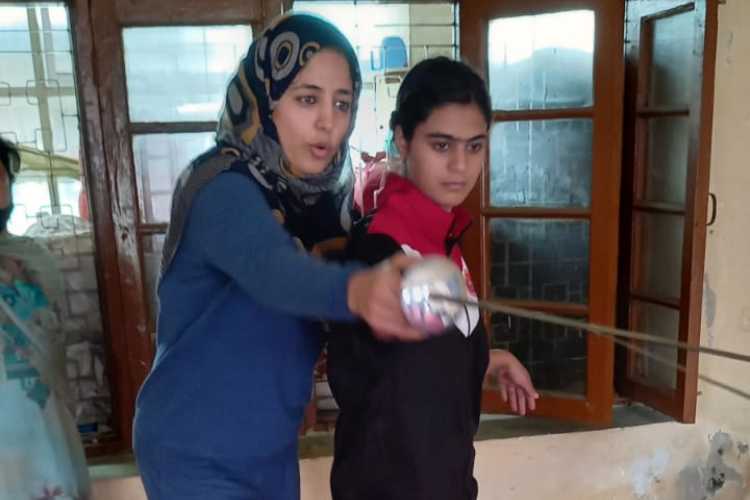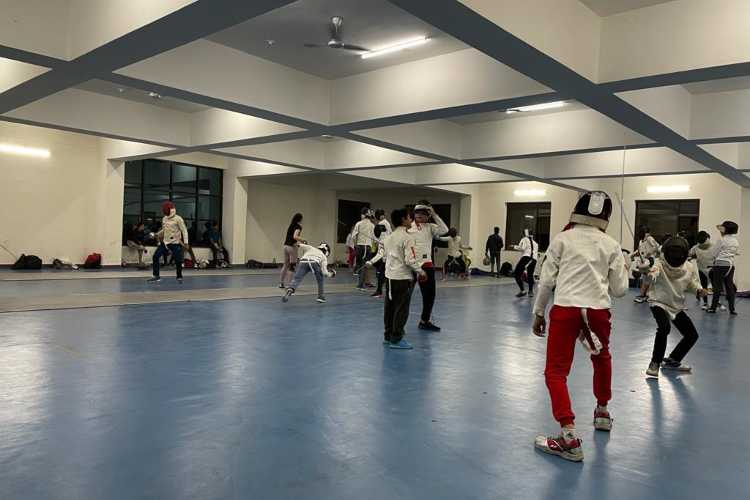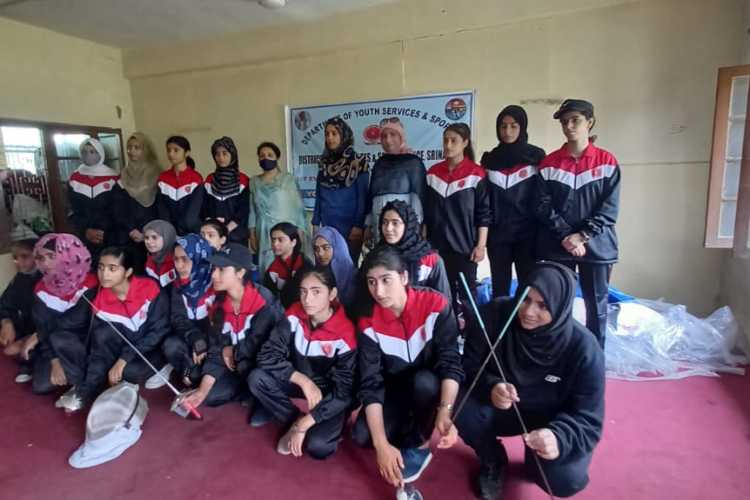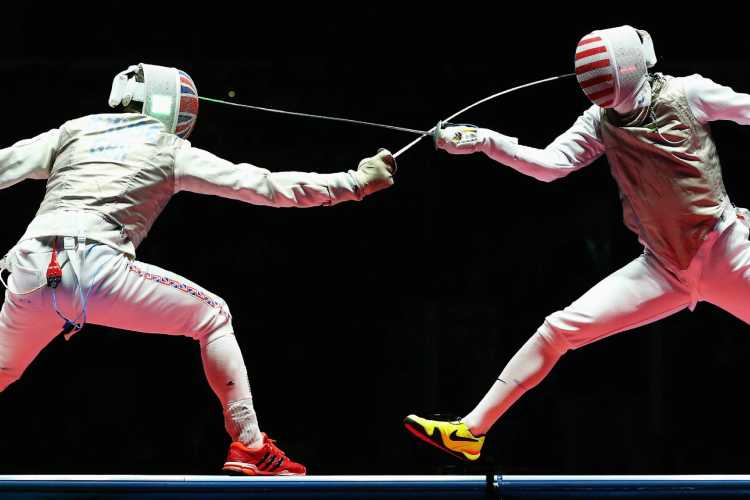
Nakul Shivani/ New Delhi
Much before Bhawna Devi brought the sport of fencing to our drawing rooms by scaling a new high at the 2020 Tokyo Olympics, a young girl was creating ripples in the Kashmir valley by carving a name for herself in one of the most majestic of all sports.
On a cold December evening, just like her namesake from medieval India, Razia Sultan guards her territory on the fencing mat with the fierceness of a warrior. The 39-year-old mother of a four-year-old son is in a crouching position, dressed in shimmering white suit ready to attack her opponent with the swiftness of a tigress.
She scores a point with a deft touch and it is celebrated with a triumphant yell. “That’s how you do it,” she tells her trainees at the Srinagar Youth Hostel.
Razia Sultan is the first female fencer from the Kashmir valley to have represented Jammu and Kashmir at the national level, and is, till date the only woman coach in the valley.
A state-level volleyball player, Razia learnt fencing while in Jammu during the 2003 winter months when outdoor activities in Srinagar were restricted due to the freezing temperatures.
Fascinated by the gear and the drills fencers followed, she started learning it. “My first coach laughed when I told him my name,” she says. But just one look with the sword was enough to convince Shotu Lal Sharma that he had a champion in the making in his hands.
.jpg) Razia Sultan is the only woman fencing coach in the Kashmir valley
Razia Sultan is the only woman fencing coach in the Kashmir valley
Her love affair with fencing blossomed further when she emerged better than a lot of her peers in Jammu. Volleyball took a back seat and she managed to convince her sports buff father that fencing is what she was cut out for.
“My father was very supportive. Initially, he did not know anything about the sport. Those days there were no ready references like google, youtube. It took some time for him and me to understand the nuances of the game.”
By 2006, she was good enough to make it to the state team. And then came the silver medal in the individual event and a bronze medal in the team event in the national championship – the first and so far, the only medal by any Kashmiri girl at the national level. “I became a bit of a hero here,” she says.
Following her success, more girls wanted to follow her footsteps. “Sometimes you need a spark for others to follow.” Razia’s medals at the national level were the spark that the Kashmir valley needed. Today there are more than 300 registered fencers in Kashmir and three districts – Srinagar, Pulwama and Anantnag have top-class training centres.
"Our girls are doing very well. They have emerged as a major force to reckon with. Soon one of these girls will wear the India jersey," says Nuzhat Gull, Secretary Jammu and Kashmir Sports Council.
But the journey of fencing in Kashmir was not smooth. In the initial years, there were problems galore. To start with, there weren’t many coaches in Srinagar or its adjoining districts, nor was there any equipment. Looking at the interest shown by some Razia took the onus on herself to find a way out.
 Many young boys and girls in the Kashmir valley are aspiring to excel in fencing
Many young boys and girls in the Kashmir valley are aspiring to excel in fencing
Even as an active player, Razia started coaching young kids in Srinagar with rudimentary equipment. “People did not know much about fencing. But after I won medals, many parents wanted their children to learn it. Also, I took up the challenge to educate people here about the sport.”
To take the skillsets of aspiring fencers in Kashmir to the next level, she went to NIS Patiala and did a one-year coaching course.
Razia started travelling to schools in the hope of drawing interest among school-children in fencing.
Once this was taken care of, came the second problem – equipment. “it’s costly, so not many people can afford it.” After years of struggle, she managed good-quality equipment for training from the Union Territory government. Today Kashmir has high-quality infrastructure to train aspiring fencers.
Razia has travelled a long way from being a player cum coach to imparting good coaching to young children.
“Way back in the mid-2000s there was no ready guide available. Everything was based on what I told children and their parents, unlike today when they can look up youtube or do google search.”
 Razia Sultan with her trainees
Razia Sultan with her trainees
Today she has under 100 children under her wings. Along with training them, she also travels to different districts of Kashmir and conducts classes for not only children but also Physical Training Instructors in government schools.
“There is a lot of talent in the valley. Children only need a good platform. The equipment has just come in here, infrastructure is being developed,” she says.
JK Sports Council has major plans to spread interest in the game in the UT. "We have plans to provide indoor halls, modern equipment in all the districts of Kashmir," says Nuzhat.
With infrastructure in place, Kashmir is today ready to produce an international medalist for the country. “What I could not do, I want the kids I train to do,” says Razia.
With the passion she has for fencing, that does not look like improbable. Afterall, she has managed to introduce a sport that can truly be called ‘royal’ to the Kashmir valley.
“Most of the children still follow cricket, football or martial art sports. fencing is still developing here. To many it may look boring in the beginning, but once they hold the sword and wear the gear, they realise how royal this sport it is,” she says before carefully packing her kit. “I am the custodian of the swords,” she laughs.
ALSO READ: Hijab-clad weightlifter Salbeena eyes Olympic medal
Razia Sultan showed the way and today more and more children of the Union Territory are picking up this sport. Awazthevoice.in spoke to Rashid Ahmed Choudhary, Convenor of the JK Amateur fencing Association who expressed optimism at the growth and success of fencing in J&K.
How popular is fencing in J&K?
Fencing is one of the leading medal winners sports in J&K in all levels including International level. J&K fencers have so far won more than 300 medals. J&K Fencing Association in collaboration with J&K sports council is promoting this Olympics sports in all districts of the UT including Kashmir division. Srinagar girls team is doing extremely well. They won the overall championship in state level fencing championship recently.
How do you see fencing growing as a sport in Kashmir in the future?
Now a days J&K Government is supporting fencing in shape of Infrastructure and modern equipment. Kashmiri youth is doing well in martial arts. In fencing, they have plenty of potential to achieve success in national and International level. Recently, Fencing Association of J&K introduced the sport in Pulwama, Pahalgam and Anantnag, and the response was extraordinary.
Rashid Ahmed Choudhary, Convenor J&K Fencing Association
What more do you need to do to see more International level players coming from Kashmir?
Recently I submitted a proposal to J&K Sports council to open a high-performance centre in Kashmir specially in North and South Kashmir. I have proposed appointment of advanced coaches. Moreover, in view of outstanding performance of J&K fencers, the government of India opened a State Centre of Excellence in Fencing in MA stadium Jammu where all the facilities are provided by the Central government in collaboration with J&K sports council.
ALSO READ: 'Main tooti Nahin': Kashmir's first women canoeist Bilquis Mir
Know the basics of Fencing:

Fencing has been part of every Olympic games
Fencing is one of the only five sports to have featured in all the Olympic games since its first edition in 1896.
There are three branches in Olympic fencing – Foil, Sabre and Epee.
In order to score points, a player must strike at different points of the opponent’s body. Both the swords and the scoring parts of the body are electronically sensitive. When a score is registered there is an audible tone and a light illuminates. Only the tip of the sword can be used to strike.
The playing area of Fencing is called ‘Piste’. It is 46 feet long and six feet wide.
There are three 3-minute rounds in a match with the winner being the first to score 15 points or the one with the maximum hits after three rounds.
